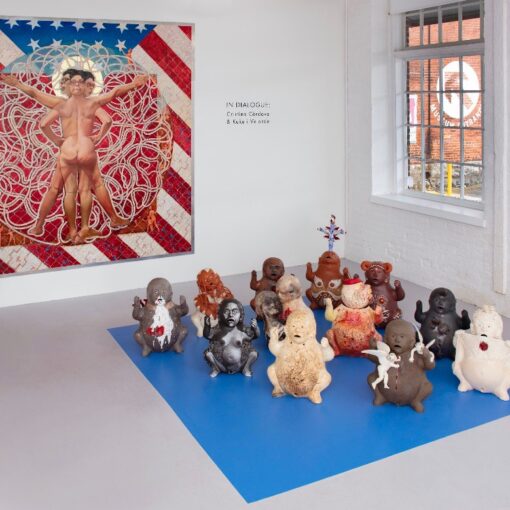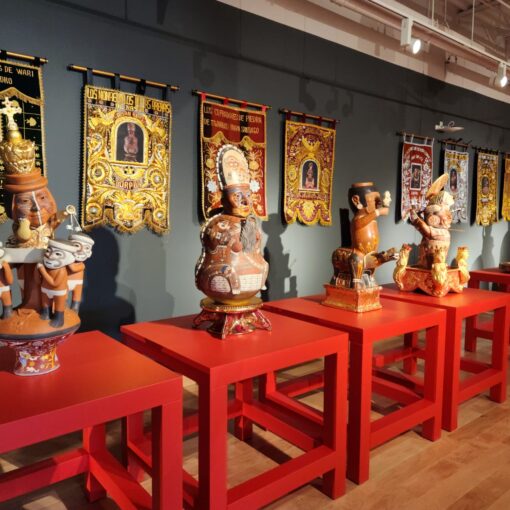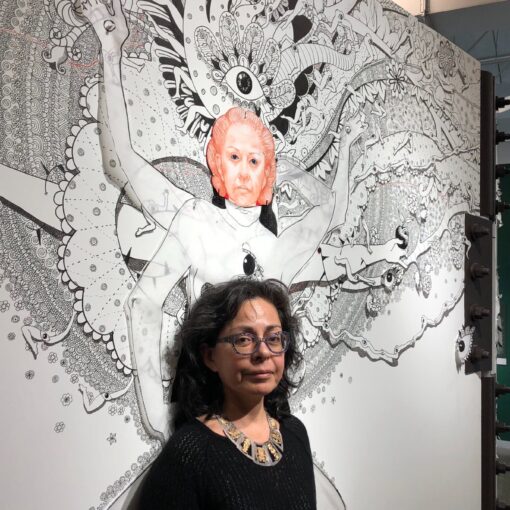As satire, Kukuli Velarde’s work is both outraged and deliciously outrageous. The Peruvian-born, Philadelphia-based artist co-opts the forms of pre-Columbian ceramics to issue a postcolonial manifesto about identity and integrity. “Plunder Me, Baby,” her show at the American Museum of Ceramic Art in Pomona, is withering one moment, wacky the next, and brilliant throughout.
A Pacific Standard Time: LA/LA sleeper, the show features two series of sculptures, a mixed-media wall piece and a selection of videos. It is also smartly augmented by examples of the kind of pre-Columbian ceramics that Velarde riffs on — small effigy urns and spouted vessels with human or animal attributes and geometric patterning. Velarde’s versions are scaled up, amped up, sexed up.
The series that gives the show its title amounts to a cunning counter-occupation. Velarde has inserted her own likeness where a more generalized human face or animal head would appear in her centuries-old models. In doing so, she asserts continuity with her indigenous roots and kicks back defiantly at the forces that oppressed, mischaracterized and dehumanized her ancestors. Her work emerges out of the psychic and cultural fallout that persists to the present.
One figure, with a patterned skin of dusty gold, teal, emerald and crimson, appears seized with fright, eyes and mouth agape. In another, Velarde affixes her watchful face to the body of a dog, leg raised, interrupted mid-lick. A terracotta figure sticks her tongue out petulantly from a face painted blood red, while two unruly dogs squirm on her lap.
Each of these temporal mash-ups has taut energy, biting wit and a long, complex title starting with a slur in Quechua, some mocking descriptions in English and Spanish, and the date and culture of the particular piece that served as the artist’s springboard: Maya, 750 BC, for instance, or Zapoteca, AD 300/700. Velarde makes serious sport of the derogatory traits assigned to her forebears, exaggerating displays of fear or passivity, roughness or disobedience. She sculpts with the vengeance of self-determination.
The other series of sculptures on view are all based on a single 16th-century Mesoamerican piece in the collection of the Metropolitan Museum of Art in New York. Velarde retains the general posture of the thick, squatting, 13-inch-high figure with its arms raised by its side, but she enlarges it to roughly 2 feet tall, transposing male features to female. She also varies the glaze, coloration and embellishment of each of the five pieces installed as a group here, extracted from a series numbering more than 70.
Feathered serpents entwine one little body with a dark, matte surface. Another figure, glazed milky white, bleeds down from the eyes and up from her gold-rimmed vagina. Velarde crisscrosses the deep sapphire skin of another with text, endowing the silent form with a vigorous voice that cries, “No, No, I am not an arqueological [sic] leftover or an antropological [sic] link. … I have a contemporary history running next to yours.”
The AMOCA show, a snappy jolt of historical remediation, makes that message urgently clear.




